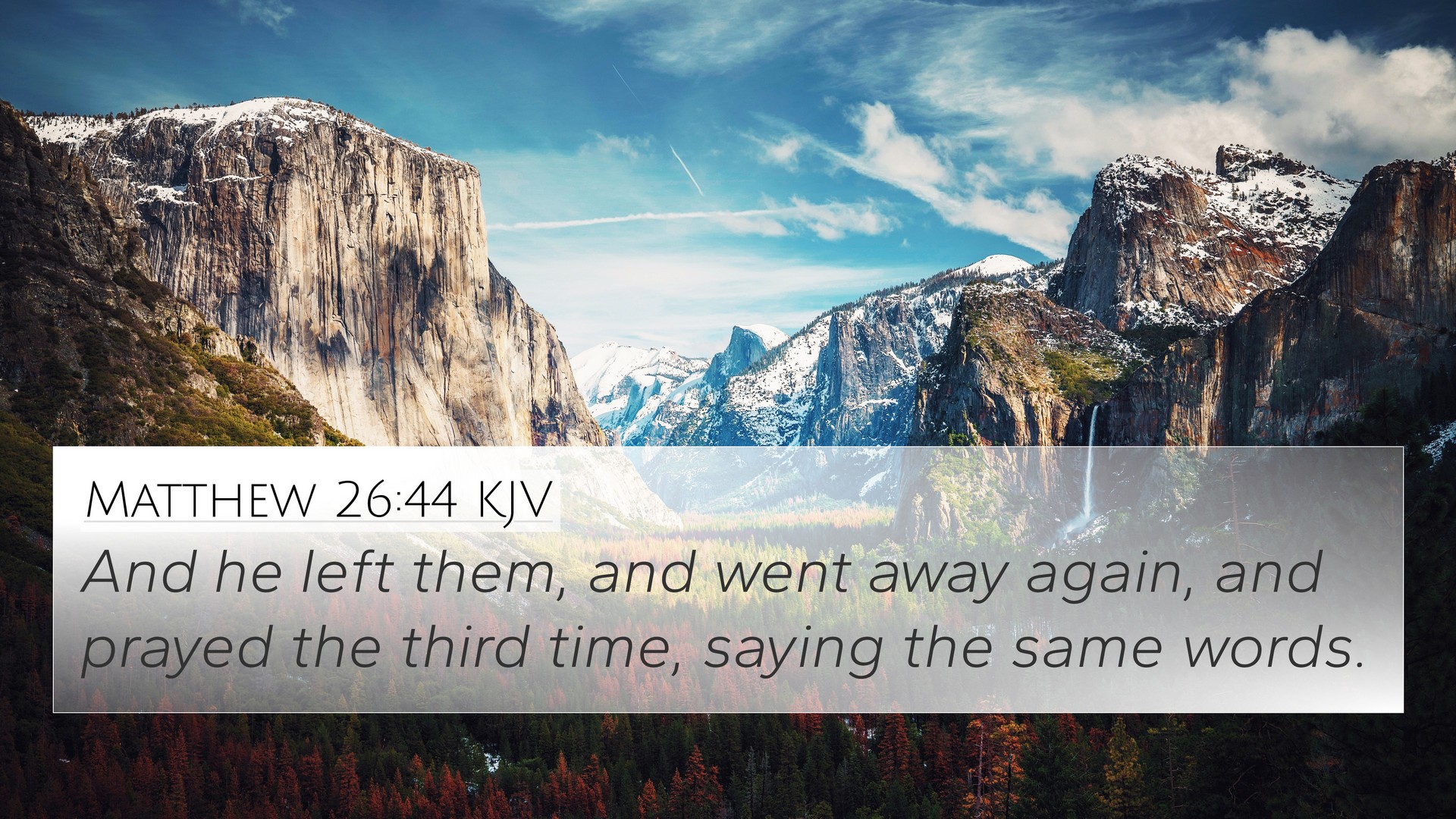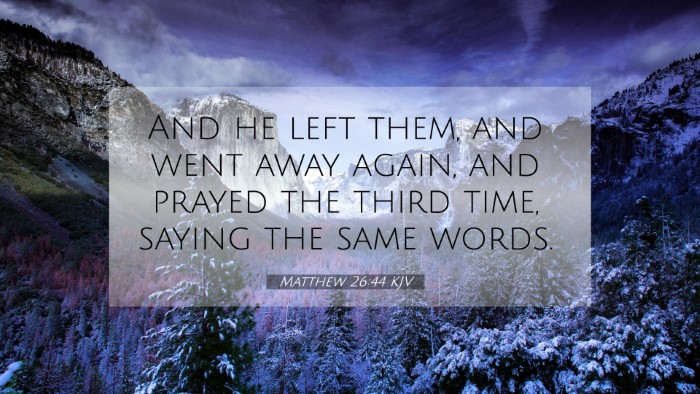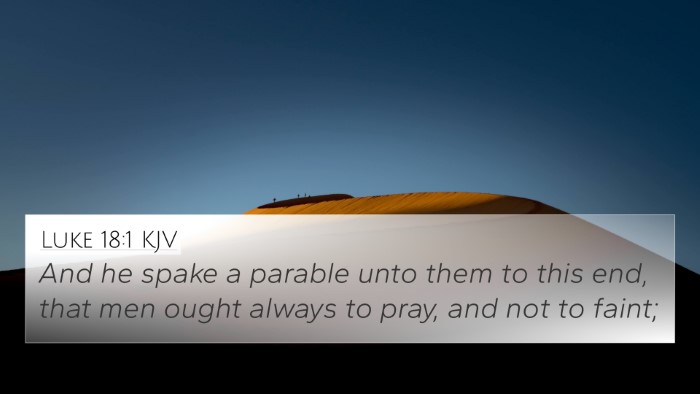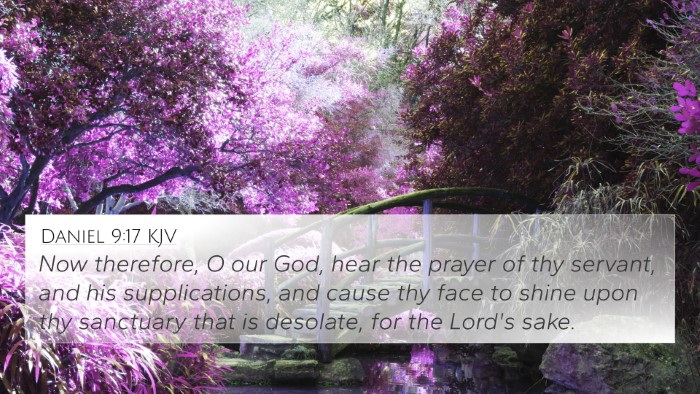Understanding Matthew 26:44
Matthew 26:44 states: "And he left them, and went away again, and prayed the third time, saying the same words." This verse captures a moment of profound significance during the Passion of Christ, highlighting the themes of perseverance in prayer, the struggle of humanity, and the divine mission of Jesus. Below, we explore the insights gained from various public domain commentaries to deepen our understanding of this passage.
Contextual Overview
This verse arrives during the scene in the Garden of Gethsemane, just before Jesus' betrayal and crucifixion. The emotional weight of this moment cannot be overstated, as Jesus grapples with the impending suffering He is to endure. Commentators like Adam Clarke emphasize the intensity of His prayer, indicating that it was not merely a request but a deep expression of His soul's anguish.
Insights from Commentaries
-
Matthew Henry:
Henry points out that Jesus prayed three times, a detail that signifies the importance of perseverance in prayer. Each instance reflects His dedication to seeking strength from the Father, illustrating the human need for divine support in times of trial.
-
Albert Barnes:
Barnes notes that the repetition of the prayer not only emphasizes the weight of Jesus' burden but also provides a model for believers. In moments of desperation, bringing forth our struggles before God, even in repetition, is encouraged.
-
Adam Clarke:
Clarke elaborates on the phrase "the same words," suggesting that Jesus' prayer was earnest, demonstrating that even in moments of distress, clarity and consistency in prayer is essential. This teaches believers about the nature of earnest requests before God.
Thematic Connections
Matthew 26:44 serves as a thematic link between various biblical contexts. The repetition in prayer mirrors similar themes found throughout Scripture:
- Luke 22:44: This verse highlights Jesus' agony in the garden, illustrating His struggle and need for divine fortitude.
- Hebrews 5:7: Here, we see that Jesus offered prayers and supplications with vehement cries, tying back to His emotional state in Gethsemane.
- James 5:16: The encouragement to "pray fervently" aligns with Jesus' example of earnest, persistent prayer.
- 1 Thessalonians 5:17: "Pray without ceasing" echoes the importance of continuous communication with God, highlighted in Jesus' model.
- Matthew 7:7: The call to ask, seek, and knock is mirrored in Jesus’ insistence on prayer in His hour of need.
- John 17:1-26: The high priestly prayer of Jesus shows His deep connection with the Father and His concern for His disciples, paralleling the need for prayer.
- Luke 18:1: This introduces the parable about persistent prayer, reinforcing the importance of not losing heart.
Cross-References and Inter-Biblical Dialogue
By studying Matthew 26:44 in light of other scriptures, we can establish a web of understanding that enhances the meaning of the text. This inter-Biblical dialogue reveals connections that inform our interpretation:
- Mark 14:39: A parallel account of Jesus’ prayer emphasizes the emotional toll of His impending sacrifice.
- Romans 8:26: The Spirit assists us in our weaknesses, much like how Jesus sought the Father in His own hour of struggle.
- Philippians 4:6: Encourages believers to present their requests to God, reflecting the spirit of Jesus' prayer methodology.
Application for Believers
The lessons derived from Matthew 26:44 are multifaceted:
- Perseverance in Prayer: Just as Jesus continued to seek the Father, believers are called to persist in their prayers, especially during trying times.
- Honesty in Prayer: The 'same words' can encourage believers to approach God with their authentic struggles, as Jesus did.
- Community in Prayer: Jesus' request for His disciples to stay awake and pray with Him indicates a call to communal support in times of need.
Conclusion
Matthew 26:44 is a pivotal verse that not only portrays the emotional depth of Jesus’ experience before His crucifixion but also establishes a blueprint for how believers should approach God in prayer. By connecting it to both Old and New Testament scriptures, one can appreciate the rich tapestry of themes surrounding prayer, struggle, and divine reliance.






